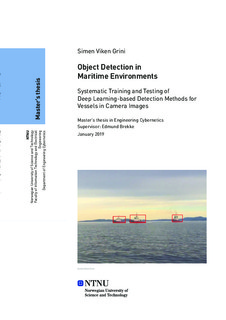| dc.description.abstract | Maskinlæringsmetoder basert pa konvolusjonelle nevrale nettverk (CNNs) har i senere år
tatt over som den dominerende teknikken innenfor objektdeteksjon. Store forskningsressurser blir brukt på å utvikle dette feltet videre, og det kommer stadig nye nettverksarkitekturer og metoder. For å kunne detektere båter i bilder må disse nettverkene trenes på et passende sett med merkede bilder. For a kunne sammenligne deteksjonsmetoder og forskjellig treningsdata bør disse nettverkene kunne trenes enkelt gjennom et gjenbrukbart og systematisk rammeverk. Å utvikle et slikt rammeverk er målet med denne masteroppgaven. Mer spesifikt ser denne opggaven nærmere pa følgende:
• Gjennomføre litteraturstudie pa eksisterende metoder for deteksjon av båter i bilder,
herunder å diskutere de mest populære CNN-metodene og andre maskinlæringsmetoder.
• Utvikle et rammeverk for trening og testing, slik at denne treningen og testingen kan
bli gjort for de mest populære deteksjonsmetodene med med minimal innsats.
• Trene og teste deteksjonsalgoritmene Yolov3 og SSD Mobilenet pa relevante data.
• Skrive rapport og diskutere styrker og svakheter for bade Yolo og SSD, på forskjellige trenings- og testsett.
Resultatene fra dette arbeidet er lovende, og viser at båtdeteksjon med kamera kan være
pålitelig i gitte situasjoner. Selv om resulatene varierer for forskjellig testdata, viser testene
at deteksjonsalgoritmer som Yolo og SSD kan detektere nærmere 100 prosent av båtene i
et testsett når algoritmene er trent riktig. | |
| dc.description.abstract | Machine learning methods based on deep convolutional neural networks (CNN’s) have in
recent years came to dominate the state of the art in object recognition. Huge research
efforts are currently being devoted to this field, and new network architectures are frequently being proposed. For the particular task of detection of ships in images, these
networks must be trained on an appropriate set of annotated images. As these tasks, which
are somewhat labor intensive, will have to be repeated many times as new networks and
improvements appear, a systematic and reusable framework is highly desirable. To develop
this is the goal of this master thesis. In particular, the thesis focuses on the following:
• Conduct a literature survey on methods for detection of ships in camera images. In
particular, the survey should discuss the rationale for the recent popularity of deep
learning techniques, include the most popular CNN approaches, and discuss other
machine learning approaches.
• Develop a complete framework for training and testing, so that both training and
testing on new image sets can be done with minimal efforts for popular networks.
While the training can accept unordered collections of individual images, it is important that the testing can work on video streams, so that temporal detection metrics
can be investigated.
• Train and test the detection algorithms Yolov3 and SSD Mobilenet on real data
• Write report and discuss strengths and weaknesses for both of the networks, and
also for different training and testing sets.
The results from the tests done in this project are promising, and shows that boat detection
with camera can be reliable in certain situations. Though the results vary for different test
data, tests show that detection algorithms like SSD and Yolo can be able to detect close to
100 percent of the boats in a test set when trained properly. | |
